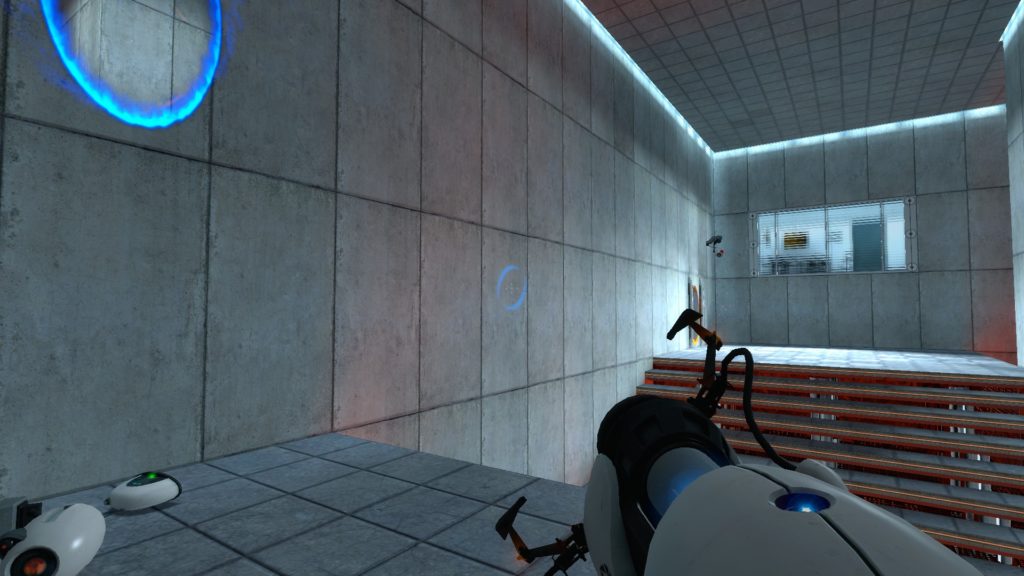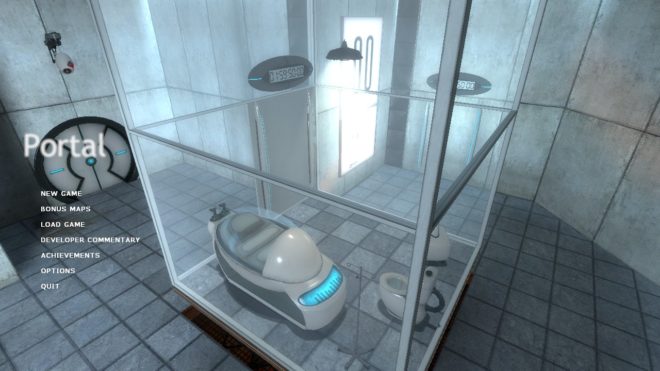A great many popular video games work well because they make effective use of a multitude of mechanics. While the best tend to revolve around variations on a singular mechanic, it takes a multitude of mechanics to make a system, and games weave their various mechanics together to create challenges for players to overcome. An instructor in my degree program frequently likens this to multi-track editing in audio programs—melodies, harmonies, and instrumentation weaving in and out to create a complex, cohesive whole. To see this mindset in action, we’re going to take a look at the way Portal introduces and refines its mechanics to create challenges that escalate in time with the player’s understanding.
Portal begins with the player locked in a glass box for about sixty seconds. During this time, all they can do is move, look around, and pick up the couple of objects sitting in the room with them.

This allows them an opportunity not only to acclimate to an unfamiliar, sterile environment, but to get a feel for the game’s basic movement before anything is required of them. The sixty-second window ends with the opening of a portal, positioned such that the player can see themselves on the other side. It’s an immediate, nonverbal communication of what portals are and how they work, and moving through it is required before the player can proceed.
If this sounds familiar so far, that’s because I wrote about this same early section several months ago for a different post. As such, we’ll take an abridged look at the next couple of puzzles to introduce the concept without further redundancy. Test Chamber 00 introduces boxes and buttons in complete isolation, building on and formally introducing the ability to pick up and move objects. Proceeding past it, Test Chamber 01 builds on this mechanic by mixing it with the other significant mechanic we’ve seen up to this point: the titular portals themselves. The player doesn’t yet have control over them, but they must use them to retrieve the box, take it to the button, and reach the door—each step of which is in a different, isolated alcove.

Test Chamber 02 takes us beyond the scope of the other post, and also sees us step away from picking up and moving objects for a spell. This frees our focus for the introduction of a new mechanic: the first iteration of the Portal Gun. The Portal Gun is one of the primary mechanics of the game, and thus, it’s critical that the player understand how it works. When a part has to be heard, the rest fades away to give it the spotlight. To that end, the entire chamber points to the gun as a centerpiece—quite literally, in the case of the arrow signs on the floor. All the player needs to do is grab the gun and use it exactly once to move on; it’s clear, effective, and requires at least basic understanding to move on.
At this point, I’d like to take a moment to introduce the chart. The spreadsheet embedded above shows each of the mechanics introduced thus far and which instances they appear in—as well as a column for the brief intro before Chamber 00. Lighter rows are sub-mechanics or extensions of the darker, broader mechanics above. Blue boxes indicate that a mechanic was significant for the puzzle or otherwise mentioned—in the case of the Emancipation Grill in Chamber 00, which we’ll talk about later. Exclamation point boxes, in orange, indicate that something about that mechanic was significantly redefined or clarified during that puzzle. For instance, Chamber 01 introduced the concept that pre-placed portals—and portals in general—could move, broadening their functionality. With that taken care of, let’s discuss how Chamber 03 redefines the player’s movement.
Test Chamber 03 picks up where 02 left off, continuing the trend of relatively simple challenges to acclimate the player to their newfound ability, the Portal Gun. The gun and the redefinition of movement are deeply intertwined because the immediate obstacle is a pit. In most games which allow the player to jump—such as any game in the platformer genre—a pit is the signal to do so.

Chamber 03 redefines movement by demonstrating what it can’t do: hurdle obstacles like Mario or Sonic. Instead, the player must fire a portal to cross to the pre-placed orange portal, then cross a second pit from it to a second player-made portal. By the time the player exits this chamber, they’ve completed a crash-course on moving through space using portals, and are thus prepared to start combining them with other mechanics.

Portal’s first four test chambers have already introduced a substantial number of mechanics and interactions with the game world—enough that an entire game could focus solely on those seen here. The rest of the game continues to refine and make use of these elements while adding more and more to flesh out the abilities at the player’s disposal. This isn’t the last we’ll see of boxes and buttons; even the game’s conclusion revolves around picking things up. However, in an effort to give each chamber the focus it deserves, we’ll pick up from this point in the next post. Check back soon to continue our deep dive into the interwoven mechanics of Portal.

